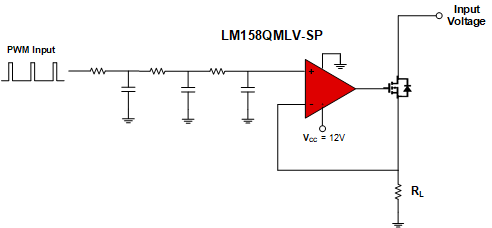TIDUEY7 July 2021
- Description
- Resources
- Features
- Applications
- 5
- 1System Description
-
2System Overview
- 2.1 Block Diagram
- 2.2
Design Considerations
- 2.2.1 System Control and Processing
- 2.2.2 Analog Front End
- 2.2.3 Input Voltage Monitoring: 5 V, 20 V, 40 V, and ±5 V
- 2.2.4 Bidirectional Current Sense: ±2 A
- 2.2.5 Unipolar Current Sense: 0.25 A to 1 A
- 2.2.6 TMP461-SP: Local and Remote Temperature Sensing
- 2.2.7 NTC Thermistor Temperature Sensing
- 2.2.8 Adjustable Voltage Source
- 2.2.9 Fixed Output Current Source
- 2.2.10 Adjustable 4-mA Current Source
- 2.2.11 Power Tree and Power Sequencing
- 2.3 Highlighted Products
- 3Hardware, Software, Testing Requirements, and Test Results
- 4Design and Documentation Support
- 5About the Author
2.2.9 Fixed Output Current Source
Figure 2-9 shows the fixed output current source which is capable supplying 4 mA with a full scale accuracy of 1.5%. The circuit is dependent on the applied supply voltage to the LMP7704-SP and the LM4050QML-SP 2.5-V reference. The supply voltage for this circuit is 12 V, which results in an output voltage of 12 V. With the voltage reference being a fixed 2.5 V, it results in a fixed voltage at the inverting input of the LMP7704-SP. This results in an equivalent voltage at the non-inverting pin. This creates a voltage drop across Ra which results in a fixed current output. To choose the output current, Ra and Rb are calculated using the following equations.
Equation 1 through Equation 4 are for an ideal reference; however, the DC accuracy of the reference can impact the current output. As seen in the test results, the output current resulted in 3.83 mA instead of the 4 mA because of the DC accuracy of the LM4050QML-SP. Therefore, to get the desired current output, Ra should be recalculated with the desired current and the measured voltage drop across the reference, instead of the ideal reference voltage.
Rc is an optional resistor to help with no load scenarios. When the load is disconnected, the output saturates but is offset by Rc; however, the trade off is that there are larger current droops at higher loads at the output.
Rd is another optimal resistor connected to the output and positive supply of the op amp to ensure that the circuit turns on and that the output rail is pulled high to the positive supply of the op amp.
Figure 2-9 shows the fixed output current source circuit.
 Figure 2-9 Fixed Output Current Source
Figure 2-9 Fixed Output Current Source